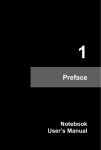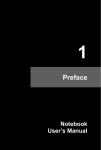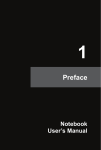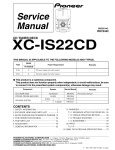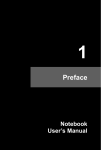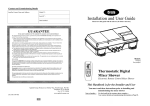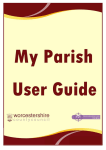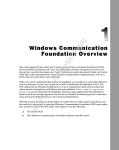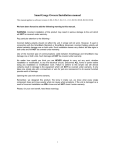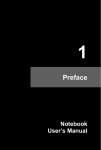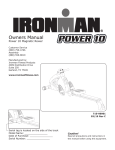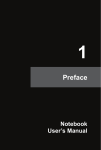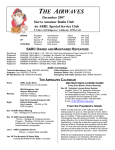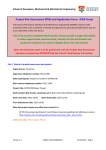Download Learning CW
Transcript
LEARNING CW WITH THE BEGALI CW MACHINE Carlo Consoli, IK0YGJ TABLE OF CONTENTS Introduction.....................................................................................................................................3 Learning CW...................................................................................................................................4 The learning roadmap .................................................................................................................4 Getting started with Morse code .....................................................................................................6 First Week...................................................................................................................................7 Second Week ............................................................................................................................12 Third Week ...............................................................................................................................14 Fourth Week..............................................................................................................................18 Fifth Week ................................................................................................................................19 Sixth Week................................................................................................................................21 Building your skills.......................................................................................................................22 Adjusting spacing to speed .......................................................................................................25 A QSO in CW ...........................................................................................................................27 Increasing speed........................................................................................................................31 Getting faster.................................................................................................................................33 Getting faster with your Begali CW Machine ..........................................................................33 Using a paddle...........................................................................................................................36 -2- Introduction The CW Machine is a unique software-defined keying device, it combines the functions of an advanced iambic memory keyer and a keyboard keyer with the functions normally performed by a logging program, and the optional CW Trainer package is a powerful learning tool. The CW Trainer is a combination of Windows software and firmware that runs on the CW Machine device. It lets you learn CW, improve your copying skills, no matter what level you are currently at, with a great variety of techniques. You can practice sending precise Morse signals by seeing your paddle movements translated into characters that are shown both, on the LCD and in the PC monitor. The Begali CW Machine and CW Trainer are extremely flexible learning tools that can be adapted to all kinds of learning processes. In this book we propose a method that relies on the book “Zen and the Art of Radiotelegraphy” 1 , adapted for the unique teaching capabilities provided by the Begali CW Machine. 1 The book, by Carlo Consoli IK0YGJ, can be freely downloaded here: http://www.qsl.net/ik0ygj/enu/index.html -3- Learning CW The learning roadmap We will approach learning in three distinct phases: 1. Learning the elements of the Morse code alphabet and their spacing. 2. Speed consolidation up to a maximum of 20 words / 100 characters per minute, using paper and pencil to copy down what you receive. 3. Increase speed and decode "in your head." In the first phase, for six weeks, we study each Morse code element, learning it as a sound, a group of characters per week. Keep practicing every day, not exceeding the time assigned for your training sessions. Practice often, for a short time.. The Begali CW Machine is an all-in-one device that, accompanied with the CW Trainer software, will follow you all throughout the learning process. We will learn the letters by groups: ETANIM / DSOURC / KPBGWL / QHFY / ZVXJ / 12345 / 67890. Letters are grouped together in increasing length. Our training will be focused on receiving and transmitting letters and numbers, copying down on paper. Sessions will last no more than 10-15 minutes a day. Speed will be starting from a minimum of no less than 10 (preferably 15) WPM. When you are able to copy on paper all the letters of a group, you move on to the next one. In the second phase, lasting about 5-7 weeks, we introduce punctuation marks and procedural signals. We also consolidate reception and transmission speed up to 100 characters (or 20 words) per minute, always using pen and paper. Do the best you can to transmit with a timing and spacing as close as possible to the one you just heard from the CW Machine. When we can copy on paper 90% of the characters sent by the CW Machine, we increase the speed by 1-2 WPM or 510 characters per minute. Our goal is to reach a speed of 20 WPM. The purpose of the third phase, of variable duration, is to achieve the delicate transition of abandoning pen and paper and decoding entirely in your -4- head. Here you will learn new words and improve your reception speed gradually but inexorably. Remember: accuracy transcends speed – it is better to go slower and be understood. Exercise the art of CW with style. Obviously, achieving high accuracy in transmission requires practice, and, if you do not try, you will never succeed. Finding a ham radio friend, patient enough for long CW contacts, is an absolute must. Go, freewheel at speeds above 20 WPM. Always keep yourself within your own limits, try to correct your errors, but don’t feel blocked or overwhelmed by them. Simply, keep going! Our goal may seem overwhelming, but if we break it down into small parts, the whole path will be developing by itself. In the course of the book you will be given specific targets, each representing only a small step and requiring solely a certain constancy of practice and study. Always stay focused to your next target and, sooner than you might think, the end of your journey will be in sight. -5- Getting started with Morse code The first phase lasts, on average, around a month and a half. It is important to respect your own learning pace: there is no hurry. After all, learning CW is not a job and should remain a pleasant hobby. At this stage we focus exclusively on letters and numbers, ignoring punctuation marks and procedural signs (in short prosigns). Relax and be sure not to be distracted; try to do your best to practice at the same time of day. Simply forget that characters are made up of dots and dashes: carefully listen to the unique sound created by each letter in terms of presence and absence of tone. Let the character’s sound be "yours." Phase 1 lasts 6 weeks, each devoted to a group of character: First Week: ETANIM Second Two: DSOURC Third Week: KPBGWL Fourth Week: QHFY Fifth Week: ZVXJ Sixth Week: 1234567890 Groups are organized by increasing character duration. The first day of each week we introduce the new group of characters and we train only to receive this group. In the remaining days of the week, we train on all the letters, and finally numbers, studied up to then, i.e., we add the groups learnt in the previous weeks. Each week, your goal is to learn a new set of characters. At the end of each week you should be able to decode 25 groups of 5 characters, writing down what you received by pen and paper and transmitting them with the proper cadence, using a straight key. -6- First Week In the first week we focus on the basic elements of metrics and introduce the first group: ETANIM The 5 letters in the group ETANIM are related because they represent all the permutations of one or two dots and dashes. After having installed the CW Machine Trainer software, launch it and access the Configuration screen. Set the Lowest speed to 10 WPM and turn the potentiometer fully counterclockwise to bring the current speed to 10 WPM. Set the Keyer Mode to Hand. The Configuration screen should look as follows: Then, access the Messages screen and select: Lesson: 0 Message: 0 Word Length: 5 Check the Groups in the Use box Select the letters E, T As in the following figure -7- Now press the Create Message button and confirm in the following dialog box. Press the Load Messages button and confirm the following dialog box. Now we are ready to begin: get ready to listen, preferably using a comfortable headset. Earphones, like the ones used in MP3 players are much more comfortable than headphones. Listen to the lowest possible volume so that you do not get discomforted or fatigued. You can plug headphones in two ways. You can plug the phones into your rig (you must enable “Transmitter Keying” in the Configuration screen to do so) or plug them directly into the output RCA jack in the back in the CW Machine. The output level is more than enough to drive headphones or a small external speaker, although this requires some soldering technique to attach an RCA plug to the cord. Relax and focus just on listening. Enjoy your first experience with Morse code. Go to the Monitor screen, press the zero key on your keypad and listen to the letters E and T. E: dit. Listen to the dryness of the single dot, focus on the spacing between two consecutive E "EE" and the same, separated by a space: "E E". Listen to the letter T: daah. Feel the difference between the letter E and T: E is a single dot and T a single dash. -8- If you find the groups to be too close each other, try setting a wider spacing to grant you more time to mentally “recap” the sound of the previous word. You can apply the correct spacing later on. To do so, go to the Configuration screen and set the Word Spacing to a higher value. The software is designed to display letters on the screen as soon as they are played by the CW Machine. Listen and build an automated mental link between letter sounds and their image displayed on the screen. If you practice every day, you will achieve the desired result: when you hear a CW word (or letter, at first), right after the space separation, the corresponding letter / word will automatically appear in your mind. Focus on the difference in terms of sound length between dots and dashes. Listen with particular attention to the relationship between the length of a dot, of a dash, and the space between the two. During the lesson we will discuss the details behind the concepts of spacing and speed. For now, just ignore such details, relax, listen and do nothing else. When you are confident with the difference between E and T, add the letter A: dit-daah, using the same steps as above, in the Messages screen. To stop the CW machine transmitting the current group, press Esc. After adding the letter A and having re-loaded the lesson, press again the zero key on your keypad to start playing the lesson. Please notice that you might save the lesson on in different memory location, so you can recap a previously saved lesson without generating it again. The CW Trainer allows you to organize material into 100 distinct messages, grouped into 10 “lessons” (0 through 9) with 10 “messages” each (0 through 9). You select the lesson and message on the Messages screen before you let the CW Trainer create the actual text. Can you hear the difference in sound between the character A and the two consecutive characters "ET"? In CW, the duration in time where a signal is present (the sound) is called Mark. Conversely, the separation among Marks is called Space. So, saying that the letter A is made up of dots and dashes is, in fact, quite a big mistake. In fact, the letter A is made up of a mark, lasting a dot long, one space lasting again one dot, then a mark 3 dots long, followed by another space, again one dot long. Now, listen again to the 3 characters, paying attention to the sound difference between the sequence of letters ET and the letter A. Here are the spacing rules (do not learn them by heart, just listen): -9- o o o o o A dot is the base unit of timing. A dit is a sound of one dot followed by a silence of one dot A daah, the sound of a dash, is 3 dots long followed by a silence of one dot. The space between letters is 3 dots long. (the dot ending the preceding dit or daah plus 2 dots) The space between words is 7 dots long (3 of the preceding letter space plus 4 dots) A correct CW transmission respecting these rules is said to have the correct timing (correct timing ratio among marks) and spacing (correct ratio among spaces). Graphic representation of the letter A and the sequence of letters ET Correct timing and spacing are the essence of a state-of-the-art CW transmission. Now add the letter N: daah-dit. Listen to the difference with the letter A. Try to depict the sound of letters as a mental image. For instance, the letter A (ditdaah) has a sound that resembles a vowel open sound, in latin languages. The N, instead (daah-dit) has a truncated sound, resembling somehow the tongue pressed up in the palate. Finally, add the letters I (dit-dit) and M (daah-daah), to complete the group. Listen carefully to the whole group of letters and relax. Take a small break, and get ready for the receiving exercise. Every day we will practice to receive groups of 5 characters. Make yourself comfortable and, first, listen to the letters and watch them as they appear in the Monitor screen. Follow the groups as they are transmitted. Stay relaxed and listen. Try to grasp the subtle differences in timing and spacing between individual letters and the various sequences as the CW Machine plays them. Now play again the same exercise with the whole five letters ETANIM and write down all the characters you manage to copy. You will notice that some - 10 - characters are harder to copy. Never mind, let them go away and keep focused on the flow of characters as they are played by the CW Machine. If you loose some character, ignore it. If you skip a group or more, again, ignore them. Resynchronize yourself until you are able to copy again. You will notice that this exercise is tiring, despite the few characters transmitted. What really matters here is that you remain relaxed. Do not get nervous for the groups that, physiologically, you will miss. The purpose of the exercises is not to memorize the letters, but to establish an automatic reaction of your brain as you listen to them. Such an automated reaction is achieved only by means of repetition. Keep in mind that relatively few people are able to establish this process automatically in a short time. The daily rhythm proposed, therefore, is purely tentative. There is absolutely no hurry: if you think it might be the case, simply repeat the same exercise as many times as you feel appropriate. If you are not satisfied with how many characters you copied one day, you can always repeat the exercise the next day, making sure not to exceed 15 minutes of exercise a day. It is crucial that you practice every day. Now, plug in your straight key and transmit the letters as they were played before. Monitor your transmission, in the Monitor screen, to be displayed correctly as sequences of 5 letters, with the proper spacing. - 11 - Second Week The second week is dedicated to the group: DSOURC As in the previous week, the first session only introduces new characters. Relax yourself, start the CW Trainer software and remove all the letters studied in the previous week. Just select the letters D and S. Listen to this sound; it does resemble the phoneme ‘D’, doesn’t it? Daahdit-dit. Listen for a while. Now add letter S: dit-dit-dit, three dots in a row yields an effect of "suspension dots". This sound is like a hiss: "ssssss" dit-dit-dit. Now go for the letter O: daah-daah-daah. Indeed, a "full" sound, much like the “roundness” of the letter O. Try to create mental images of letters and words, try to create emotions while listening to CW. Learning is much faster and powerful if you add three important elements: o o o Authoritative sources of information. Repetition Emotional intensity of the experience. Keep “coloring” your study with emotions: you will learn at a faster pace and with an unimaginable simplicity and ease. Now add the letter U, the mirror of D: dit-dit-daah. The final dash seems almost like an accent, a resembling the sound of the letter U (as it is pronounced in Italian). The letter R, dit-daah- dit, is special because it is the first to introduce a syncope, i.e. a change of speed, with a dash between two dots. The middle daah recalls the sound of your tongue against the palate, typical of the phoneme R. Finally, the letter C: daah-dit-daah-dit, the first character to be composed of 4 elements. You will hear it many times in your career as an amateur radio operator, because it is the first letter of CQ, the letters of a “general call” (aka seek - 12 - you). The letter C is probably the most famous of the 26, with its very characteristic swing. Now is time to practice receiving the new group of 5 characters just introduced. As in the previous week, first you listen to the groups while watching the screen and then practice receiving the same letters copying them down with paper and pen. After that, transmit the group just sent by the CW Machine with a straight key, and check your transmission to be correctly spaced. Tomorrow, you will add to the DSOURC group the letters studied in the week before, thus training on a set of 10 letters, ETANIM and DSOURC. Repeat this exercise every day, for the whole second week. - 13 - Third Week The group of the third week is: KPBGWL All the characters of this group are made of 3 or 4 elements. Listen carefully because they differ from the characters of the preceding groups only in how the elements (dots and dashes) are combined. Thus, K is an R with dots and dashes reversed, the same holds for G and U, D and W. Always remember to listen to sounds. Try to build a mental picture, to give a “shape” - the one that best suits you - to each sound. This will help you to establish an automatic reception reflex between the sound and the mental visualization of the correspondent letter. Now relax, run the CW Trainer software and configure it to play the letters K, P. K: daah-dit-daah. Mentally recall the difference with the letter R (dit-daahdit). Notice that, while visually inverted, the two letters have a completely different sound. Now add the letter P: dit-daah-daah-dit. The letter P is a consonant whose sound is distinctive because, although it has 4 elements like many other consonants, the two central dashes give it a unique sound image. Keep listening for a while and get ready to take a break. The introduction of the letter P allows us to better define the concept of speed in CW. The unit of speed is the WPM (Words Per Minute) or CPM (Characters Per Minute). An E, for instance, takes a fraction of the time of an A. Thus, the measured speed in character per minutes depends on which characters are actually sent. To overcome this problem a standard measurement system has been defined to evaluate speed in words per minute. The base unit of measurement is the word PARIS. - 14 - Elements of the letters in the word PARIS Let’s do a quick calculation of the number of dots, our elementary timing unit: Letter P: 11 dots + 3 of letter spacing. Letter A: 5 dots + 3 of letter spacing. Letter R: 7 dots + 3 of letter spacing. Lettera I: 3 dots + 3 of letter spacing. Lettera S: 5 dots. Word spacing: 7 dots. By summing all, we get a grand total of 50 dots, including the word space at the end. - 15 - One word per minute (WPM), therefore, corresponds to 50 dots per minute, 2 WPM to 100 and so on. It has been agreed, as a convention, that the speed in CPM is evaluated by multiplying the WPM speed by 5. One WPM corresponds, then, to 5 characters per minute. Now let’s split the sample word PARIS in dashes, dots and spaces: o o o o 4 dahs 10 dits 9 separation dots between dits and dahs 19 separation dots between characters (including 7 of word spacing) in total, 38 dots and 4 dashes. The following table shows the relation among speed (for a 3:1 weighing ratio) using different units of measurement: WPM, CPM, baud and dot duration in milliseconds: WPM CPM Baud Dot (ms) 5 10 15 20 25 30 35 40 50 60 70 100 150 200 25 50 75 100 125 150 175 200 250 300 350 500 750 1000 4 8 13 17 21 25 29 33 42 50 58 83 125 167 240 120 80 60 48 40 34 30 24 20 17 12 8 6 Comparative table of speeds in different units of timing - 16 - Now add the letter B: daah-dit-dit-dit. Sounds "slippery", does it not ? Then, when you feel comfortable, add the G: daah-daah-dit, although it is like an U with dots and dashes reversed, it has an unmistakable sound. With the letter W: dit-daah-daah, we complete the set of palindrome letters (the W, in addition to being a D with dashes instead of dots, is the reverse of a G). Listen to the sound and let your automatic sound-image mechanism work for you, the rest will follow. At last, the letter L: dit-daah-dit-dit is the third character we meet composed of 4 elements. From the next week on we will learn all the letters made of 4 elements. Listen to them carefully. Now continue training as usual, receiving the groups of the first day while watching the screen and, then start receiving them using paper and pen. Again, practice in transmitting the three groups studied up to date with your straight key. The rest of the week is devoted to rehearse the whole set of groups met to date. - 17 - Fourth Week The fourth week group is made of only 4 characters. QHFY As always, get relaxed and listen to the letter Q: daah-daah-dit-daah. C and Q make the most famous sound, heard daily by radio amateurs all around the world: CQ. Hearing a CQ, immersed in a background noise, with a small radio receiver and a small antenna, even better from an isolated island in the ocean is an unforgettable experience. The letter H: dit-dit-dit-dit, completes the series of letters composed by dots:,E, I, S, H. Carefully listen to the difference in sound between an S and an H,. At high speeds they become very similar, except small details that a trained ear and a relaxed mind can grasp with ease. The F: dit-dit-dah-dit, is quite similar to the letter L, listen to it again and again. It is advisable to practice with a dedicated listening session, with only the letters F and L. Relax, listen to the sound and simply watch the letters as they appear on the screen, right after their sound is being played. Finally, the Y: daah-dit-daah-daah, which differs from the letter C for the final dash, but it sounds radically different. Both these letters are included in the group of this week. Use the excersises of the first day of this week to practice with the letters and, thus, become familiar with the sounds of Q and Y. As always, it is now time to listen watching the screen and, then, decode the letters, copying with paper and pen. Finally practice in transmission. Tomorrow, you will repeat the same exercises adding the four groups studied up to date. - 18 - Fifth Week With the fifth week we finish all the letters of the alphabet: ZVXJ Start listening to the letter Z, V. Z: daah-daah-dit-dit. Over the years, I associated the "long" sound of the first two dashes and the short of the two end dots with the graphic sign of a Z. Try to visualize the sound, giving it a “shape”, a “color”, or some general “tangible” attributes. The more senses you involve in learning, more intense will be the lasting memory of what you have just learnt. Listen now to the letter V: dit-dit-dit-daah. For decades it has been the beginning signal for coastal broadcasting stations around the world. It has a distinctive sound: it seems the attacking tune of the fifth (in Roman numerals, incidentally, V) Symphony by Ludwig Van Beethoven. The letter X: daah-dit-dit-daah is rather unique, because of the two central dots. It is a P with dots and dashes inverted but, again, it has a completely different sound. Finally, the letter J: dit-daah-daah-daah, it sounds quite lengthy, and could be confused with the W because of the final additional dash. Carefully listen to how to the sound differs from the letter W. Despite what one would expect, the “most difficult” letters are the shorter ones, because they require you to react much faster. The letter J, for example, consists of 16 dots (always remember to count marks and spaces): twice as long as an S and four times longer than an E. It is therefore important to learn the letters by sound, not by their graphical elements. If you do so, you will incur a series of handicaps that, to be corrected, will require a painful work. 1. If you memorize dots and dashes you will be forced to split each single letter you receive into elements. This will require a very long decoding time. 2. Longer letters will be extremely difficult to learn. 3. When increasing the speed you will compound the problem of decoding the short letters, because they are too fast, and the long ones, because they are too complex. 4. It will be almost impossible to exceed the speed of 40 characters per minute. - 19 - Now, go on with the usual exercises, throughout the week, starting from tomorrow and going on for 6 days: you will practice with the entire alphabet. You are almost done! As always, first watch the groups as they are played on the monitor screen, then copy them with pen and paper and, finally, transmit them with the straight key. Remember: stay relaxed, let the mistakes go away and stay focused on what you receive. Eventually, skip the whole group of 5 characters if you should miss two or more consecutive characters. Get resynchronized during the space before the next group. - 20 - Sixth Week With this week we introduce the numbers: 1234567890 There is a simple mnemonic rule: o o o All numbers are all 5 elements long. Numbers from 1 to 5 start with 1, 2, 3, 4 5 dots. Numbers from 6 to 0 start with a dash, up to 5 dashes for the number 0. You can directly listen to the whole set of numbers, altogether. After a few minutes the mnemonic rule will become obvious: a 0 is so long to be unmistakable. Pay attention to the difference between 2 and 3, and between 7 and 8. Now continue training as usual, receiving the groups of the first day while watching the screen and, then start receiving them using paper and pen. Again, practice in transmitting the whole groups studied up to date with your straight key. Congratulations! From the second day on you are decoding the whole Morse code alphabet! - 21 - Building your skills This stage of learning is aimed at increasing reception and transmission speed up to 20 WPM. The work we did in the previous phase over the course of a month and a half is the basis for correct transmission, with the proper timing and spacing. Only a series of carefully designed daily listening sessions, for an extended time, can produce a mental representation of the sound of each letter. By the end of this phase you will be able to transmit with a rhythm as close as possible to the ideal, i.e. with a proper weight ratio of 3:1 and correct spacing between letters and words. Training sessions will all take place in the same way: Listening to groups of 5 characters. Transmission, using a telegraph key, of the same groups. The second phase may have a minimum duration ranging between one and two months, but it is highly advisable that it lasts long enough to allow you a proper absorption of rhythm and spacing, both in transmission and reception. Objectives of the second phase are: o o o Match the spacing between words to the speed of 15 WPM. Make your first CW contacts (QSO). Gradually increase reception and transmission speed up to 20 WPM In the first phase we learnt all the elements of the Morse alphabet, eventually we also applied a spacing between groups of characters corresponding to a speed slower than 10 WPM. Turn the potentiometer to bring the current speed to 15 WPM. Check to have the keyer mode set to “Hand”. Set the Char Space to 4 and Word Space to 8. In this way, we will be training on faster characters, but transmitted with a wider spacing. - 22 - The CW Trainer software can play the characters with adjustable speed and spacing among words. We will use this feature to facilitate the learning process. After we have learnt characters at a good speed, we will focus exclusively on reducing the spacing. At this stage you should practice in daily sessions of about 5 minutes in reception and do your best to transmit the very same characters you just received to reproduce the same speed, spacing and rhythm produced by the CW Trainer. When you are able to copy on paper about 90% of the characters, then you increase the speed gradually up to 15 WPM. After the initial uncertainty in transmitting with a straight key, you will immediately notice that it is significantly more difficult to receive than to transmit (although, it must be said, that transmitting with the proper timing and spacing is extremely difficult). This is not a trivial consideration: at high speeds things get reversed! We said that the minimum duration of this phase is a couple of months but if you really want to achieve excellence, it should be much longer. In fact, it is in this phase that we instinctively acquire the elements of rhythm. If you deliberately shorten this phase, which - ideally - should last at least a year, it will be very hard to fix the consequent bad habits you might have introduced. It is also time to make your first QSO in CW. The best approach would be to find a colleague to act as a sparring partner, much as in boxing. It is important that, in your training sessions, the band where you practice is silent (VHF is - 23 - perfect in the first 150 kHz, specifically dedicated to CW) and that your training partner is as precise as possible in transmission, at least in the first weeks. Normally, you reach 15 WPM in about a month and, at this point, you are fully equipped to make CW QSOs on a regular basis. Directly practice to transmit the new characters, always concentrating on the sound that you hear. Train yourself to transmit short sentences with punctuation marks. Train using the whole set of 40 characters. Go to the Messages screen, and press the Letters and Numbers button. Your screen should look like this: As you practice transmitting, also introduce the procedure signals (see the paragraph “the QSO in CW”) and the punctuation marks, you can enable them in the Messages screen: Now, as always, press the Create Message button, confirm in the dialog, and send the letters to the CW Machine with the Load Lessons button. Remember that you can save lessons in different message banks. If the groups are too close to each other, reduce the overall speed by increasing the word space as required. - 24 - Adjusting spacing to speed In the last weeks, you learnt the elements of the Morse code alphabet at a speed of 15 words per minute, listening to groups of 5 characters, deliberately wide-spaced to give you the opportunity to visualize the characters and write them down comfortably. We have seen, however, that a correct CW transmission is based on the relationship between mark and space and on a proper rhythm. We now shorten the space between groups of 5 characters until we achieve the correct spacing, corresponding to a speed of 15 WPM. Training sessions are divided into two parts, one for receiving and one for transmitting. In transmission do your best to replicate the same spacing you just heard, as produced by the CW Machine. Remember, if you lose a letter, simply let it go, get resynchronised with the stream of characters, even skipping the entire group. Then, check what you received: if you have copied at least 90% of the characters (missing at most a dozen characters), you can increase the effective speed, reducing the Character and Word space. Take note of the characters you miss more often and work on them using the character generator of the CW Trainer, selecting only those characters. At the end of the reception session, grab your straight key and practice transmitting. Transmit the characters you just received, maintaining the same rhythm and spacing as played by the CW Machine. Remember: your goal is to train on the whole set of characters and reduce the Character and Word space down to 2 and 4, respectively. At the end of this training period, you will be exercising at 15 WPM effective code speed. At 15 WPM effective code speed, your Configuration screen should look like this - 25 - Every day, generate a new lesson, by choosing the whole set of letters and numbers. It would be advisable to save 7 lessons files so, when you get to the groups of the seventh day, you will start over again with a group with which you already had practice. With the CW Machine this task is easy: just save the Monday lesson as Message 1 and the Sunday as Message 7. You will press, then, the corresponding key on the numeric pad to start the lesson every day. The fact of repeating groups listened to a few days before is of great advantage, because it reinforces your automatic reception reflex. After a few weeks, you will feel like "cheating" because, maybe, you heard the beginning of a group that you might know by heart. This is what we want to achieve: by that time you will have reached the very purpose of receiving CW, i.e., to associate groups of sounds to mental images. This is a very valuable capability, we will return back to this later. Take your time: it is a game. If you reach the target within a week it is very good, but if you should take two months or more, it is even better! You will have, then, learnt this valuable ability much more intensely. The more time you spend repeating your exercise, the better your skills will become. - 26 - A QSO in CW When you're ready or you feel like going on-the-air, you can start having fun with CW by making your first contacts or QSOs. It is advisable for you to make the first QSO when you have adjusted the spacing to the speed of 15 WPM. Seventy-five characters per minute are a more than respectable speed for contacts in telegraphy. At this speed the sound of CW is simply spectacular, provided, of course, that it is transmitted with a rhythmic and correctly spaced pace. It is like tasting a vintage brandy. Enjoy these magical moments. The CW QSO relies on three important elements: o o o Abbreviations and Q code. Procedural signals (in bold, are sent together as one character). A more or less defined structure. The rag-chew QSO is, instead, a purely free-wheeling conversation. The following list shows the main Q codes, abbreviations, and procedural signs (in bold): QTH: station location. PSE: please AR End message TNX: Thanks FR: for UR: your HR: here CQ: General Call “Seek You” SK: end of transmission HPE: hope CUAGN: See You Again 73: Greetings K: Call to transmit (go on ) KN: Call to transmit only for the station being called GM, GA, GE: Good Morning, Afternoon, Evening (to be used depending on the time of day) BT: speech separation (displayed by the Begali CW Machine as = ) OM: old man, ham radio operator ES: the conjunction "and" QSB: fading QRM: noise from other stations QRN: atmospheric noise HW: How do you hear me? INFO: Information - 27 - RPRT: signal report DR: dear OP: operator name, used in place of NAME RIG: Transceiver ANT: antenna PWR: output power WX: Weather, weather conditions (CLOUDY, SUNNY, CLEAR) TMP: Temperature BK: break, used to pass the key to the other station without using the callsign R: received, I confirm, I have understood FB: Fine Business, good VY: very TU: Thank You QSL: postcard for contact confirmation, it can be VIA BURO (via ham radio local qsl service) or VIA DIRECT (via conventional snail-mail) QRS: can you send slower ? QRQ: can you send faster? AGN: retransmit the last message SRI: sorry GL: Good Luck GD: Good The signs in bold are the so-called Prosigns (procedural signs), providing control signals to the QSO. They are sent as a single letter, for example: KN -.- -. The general call, or CQ is made in this way: CQ CQ DE IZ0AAA IZ0AAA PSE K The response to a call is: IK0BBB DE IZ0AAA K - 28 - At this point, once the two stations hear each-other, the first station replies: IK0BBB DE IZ0AAA GM OM =TNX FER CALL = UR RST 599 QSB = MY QTH IS ROME IS ES MY NAME IS PAOLO = HW? IK0BBB DE IZ0AAA K CW has something to do with chivalry. A correct CW contact relies on the following unwritten rules: always transmit at a speed allowing you to avoid mistakes always greet and thank the other station and answer any questions always slow down to match the speed of the slower operator, even if it were just 10 characters per minute. It is recognized as good practice to repeat the name and QTH twice, while IS and ES can be omitted. So, the first calling station says good morning / afternoon / evening and thanks the correspondent for the call. Next, the caller passes the signal report using the RST scale: R - Readability 1 to 5, S – Signal Strength 1 to 9, T - Quality of tone from 1 to 9. If there is QRM, QRN or QSB, such information must be given right after the RST report. The station then, which was asked HW, in turn should provide his RST report right after the pleasantries: IZ0AAA DE IK0BBB = GM DR OM PAOLO TNX FR RPRT = UR RST IS 599 = QTH ROMA OP PIERO = MY RIG IS FT 817 PWR 5W ES ANT IS VERTICAL = HR WX IS SUNNY TEMP 10C = IZ0AAA DE IK0BBB K If a station did not copy something, a question can be asked (always PSE) without repeating calling and caller callsigns, by means of the prosign BK BK DE IZ0AAA PSE UR PWR IS 5W? BK BK DE IK0BBB R MY PWR IS 5W BK - 29 - if you did not understand the answer, you may ask to repeat the last message: BK DE IZ0AAA ?? SRI QRM PSE AGN BK if the correspondent says he still did not copy, it is imperative to repeat the requested information more slowly two or three times BK DE IK0BBB R MY PWR PWR IS 5W 5W BK after the response, you confirm you understood and go on with the QSO: BK DE IZ0AAA R R TNX FR INFO VY FB UR PWR ES 5W QRP = MY RIG IS FT 817 PWR 5W ES ANT IS DIPOLE = HR WX IS CLOUDY TEMP 12C IK0BBB DE IZ0AAA K Notice that it is appropriate to first thank for the information received and, then, return the same info to the sender. At this point the QSO can be closed or go on indefinitely, even if in most cases it is ended here. Of course, with some common pleasantries: IZ0AAA DE IK0BBB DR PAOLO TNX FER INFO ES FER QSO MY QSL VIA BURO = IZ0AAA DE IK0BBB 73 ES HPE CUAGN SK TU usually, after the TU you end up with the classical "two bits", i.e. with two final dots (dit - dit). Again, the corresponding returns the greetings. BK DE IZ0AAA TNX FER VY FB QSO DR OM PIERO MY 73 GL ES GD DX IK0BBB DE IZ0AAA 73 SK TU As you practice QSOs, try if you can already leave paper and pen aside and write down only the main information, like names or cities. - 30 - Increasing speed The objective of this phase is to increase the effective transmission and reception speed up to 20 WPM, the practical limit for receiving by copying down with a pen and paper (unless you follow a special training). Up to now, you are able to receive and transmit in CW with a spacing that is consistent with a speed of 15 WPM or 75 characters per minute. The exercises are held in the same way: you first receive groups of 5 characters and repeat them by transmitting with a straight key. When you are able to copy characters and lose at most a dozen of them, increase the speed of a step by simply turning the speed potentiometer. The main indicator of the effectiveness of this process is your level of relaxation: always choose places, times, methods and tools that make you feel more relaxed and serene as possible. This phase is delicate and must be conducted with the policy of the ‘small steps’, it is absolutely inappropriate, therefore, to change your straight key. Use the character generator of the CW Trainer software and change groups day by day. In transmitting, as usual, focus on proper rhythm and spacing. If necessary, try listening again, to part or all of the characters you just received. Watch your manipulation as it is decoded by the CW Machine, pay close attention to the correct word spacing. Limit the duration of the training sessions to 15 minutes, no more. Instead of training more at your PC, increase the number of QSOs you make on the air. Remember that effective learning, at any stage, is based on repetition and relaxation. If you cannot find a quiet time of day and a quiet spot for your training, you will have a better chance tomorrow. It is important to avoid practicing in conditions of haste, anxiety or stress. Increasing your speed is a very delicate phase of your learning processes. Respect your own pace and trust your innate learning ability, all difficulties you will be facing are quite physiological. The problems that arise in this phase are common to everyone. Well known problems are: The Plateau: around 15 WPM you will notice considerable difficulties to increase your speed. This is the phenomenon of the so-called "Plateau" or threshold. Simply keep working and exercising, once you have progressed beyond a plateau you will advance quite quickly up to the next one. Typically, people find plateaus at 15, 20, 30, 40 WPM. The most important plateau is undoubtedly found - 31 - when trying to abandon paper and pen and start copying in your head. If you find a plateau, it is useless to train harder. Just make QSOs for a few minutes a day and eventually you will overcome that barrier. Sense of regression: especially in transmission, you will feel to have worse performances as compared to the past days. It is a good sign, it means that your brain is overcoming a plateau and, suddenly, one morning, you will make QSOs with no problems, even advancing a couple of WPM. Try to lower the frequency of your workouts. The tendency to anticipate characters: it may happen to you to mentally anticipate the ending of a word while it is being transmitted. Often, the result of this habit is that you lose the rest of the whole word or phrase. If it should happen, never mind; just ask for repetition of the lost message. Try to stay focused on the sound of the stream of characters, forgetting the characters that you just received and ignoring those which are yet to be received. Concentrate on what it is going on right now. This is essential in CW. Fatigue: when you start doing CW, after a few minutes, you may notice a decline in your performance, both in reception and in transmission (often this happens especially in transmission). It is absolutely normal, your brain is learning to work in a different way, by activating and physically sculpting new areas. This is rather fatiguing. Do not worry or blame yourself, it is our human nature. If you eventually should feel fatigued, simply turn off the radio and go do something else. As in sports, it is useless to demand more from a strained muscle, better stretching it. So, just relax doing other things. If you wish: listen to classical music, take in a bit of air, go for a walk, or whatever relaxes you. Like muscles, the brain is trained in response to a stimulus of stress, and changes its shape. Just take your time. - 32 - Getting faster Getting faster with your Begali CW Machine In CW, at higher-speeds, we need to decode in a spontaneous and automatic way, with ease of mind and relaxation, by activating the automatic processes allowing us to listen and transmit in CW with a rhythm and spacing appropriate to the speed. Leaving behind paper and pen is quite delicate because it is a step requiring the introduction of an automatic decoding process Luckily enough, you do not have much more to learn, you just have to keep working and be active. In short: practice, practice and again, practice. Increase the frequency and duration of your training. QSO with as many stations as possible and, most importantly, match your transmission and reception speeds. At a speed of about 25 - 30 WPM, you will start noticing how hard is to cope with bad habits (such as incorrect timing and spacing) you might have acquired in the previous phases. These habits often require painful work to be undone. High-speed transmission becomes an art in itself, requiring a lot of practice and a trained ear. The CW Machine allows you to monitor your transmission and visually rehearse it, this is an extremely powerful facility. Keep monitoring your transmission on the Monitor screen. Obviously, arriving at a remarkable accuracy in transmission requires practice and if you never try, you will never succeed. It is essential for you to find a colleague / friend and arm both of you with holy patience for long freewheeling QSOs in QRQ. Just send code, trying eventually to correct mistakes, but not to be blocked by them. At these speeds, you must practice to learn the sound of the most common words, which must be copied in your head, without transcribing them. Start listening to stations transmitting in your own language; initially you may understand few words, but as soon as you understand them for the first time, you will not forget them any more. Save some newspaper articles in text format and make the CW Machine play them for you, select your preferred operating speed and keep listening, without writing. You will soon discover you will have formed a real vocabulary of words whose sound is unmistakable. - 33 - To train yourself to receive common words, you can edit the Words file and save it in the Messages screen of your CW Trainer software. Assume a relaxed attitude, without even asking yourself the question if you are able to decode: just listen. You can edit the Word List file pressing the Edit Word List Button, then select the Word List radio button and Create Message. This will store the message in the message bank you chose, for example selecting Message: 0 as here: Will store the message in memory position 0. Just press 0 on your keypad to transmit it. When practicing with words, enable the Flashcard mode, so the CW Trainer Manager program will display the word after it is completely played by the CW Machine. - 34 - The Monitor screen should look like the following: Consider also applying more Word Space, so to train on faster words sent with wider spacing among them. In the example above, the single characters are transmitted at 25 WPM and the spacing among word is set so the effective code speed is reduced to 15 WPM. When you feel confident, instead of increasing the character speed, reduce the word spacing and bring the overall effectice code speed to 25 WPM. If you still did not abandon pen and paper, you can hide (Hide button) the text box above and copy down what you received on a scrap book. Right after, you simply unhide the text box and check what you received by comparing it with the Monitor screen. - 35 - Using a paddle A straight key is best suited for slower speeds, while a paddle will take you to interesting speeds for studying and you will find big fun in practicing with it. The adoption of a fast key will push you to transmit faster and, thus, to increase your reception speed at the same time. Changing your key is not painless, but it is a necessary step. Keep trying harder, even when you appear to be at a standstill. If you find progress too hard, try suspending or lengthening the time between training sessions. Keep up your activity in QSOs / DX and simply enjoy your Begali CW Machine while training. The paddle allows reaching speeds much higher than a straight key (60 WPM); it is essentially made of two switches, activated by two levers: one for the dots and one for the dashes. Being “only” a double switch, it must be used in combination with an electronic keyer (or just keyer). The CW Machine is a very sophisticated keyer, and you are encouraged to discover its many uses by yourself, by carefully reading the supplied user manual. The paddle, for a right-handed operator, works as follows: o o The right paddle emits dashes, while holding down it, the keyer sends a series of dashes. The left paddle emits dots, while holding down it, the keyer sends a series of dots. - 36 - The dual-lever paddle allows you to transmit alternating series of dots and dashes through the technique of squeezing, i.e. pressing both the paddles at the same time: o By pressing the right paddle, keeping it pressed, then pressing the left one and holding both pressed, the keyer sends a series of dash-dot. o By pressing the left paddle, keeping it pressed, then pressing the right one and holding both pressed, the keyer sends a series of dot-dash. The recent surprising results of the high-speed CW world championship held in Pordenone, HST 2008, seem to show that squeezing, at very high speeds (over 70 WPM in transmission), is less efficient than a non-squeezing technique used with a single-lever key in the hands of an expert. Since 2009, Piero Begali is the only manufacturer for such a of single-lever key, named HST. A paddle is made of: o o o o o o o Rigid and heavy base. Double or single lever. Double or single lever fulcrum. Contact for dots and dashes. Screws and locknut fasteners for the contact spacing of dots and dashes. Magnetic or spring retention system for adjusting the paddle resistance to motion. Finger pieces. - 37 - Like for the straight key and, generally, for all telegraph keys, the base should be as heavy as possible to make the key stable. The paddle is manipulated horizontally in both directions, so it is extremely important that it stands still, practically nailed to the desk. A shift of a few tenths of an inch, with a paddle, may change the timing enough, already at 25 WPM, to make a mistake. The lever, whether double or single, must be light and rigid, and must react to provide a consistent feeling during manipulation. The precision of the bearing where the fulcrum is hinged to is therefore crucial. It is of fundamental importance that the bearing is protected from dust or dirt. The distance between finger pieces and fulcrum and from the fulcrum to the contacts defines the paddle leverage ratio. Keys designed for QRQ have a leverage ratio close to 1:1. Contacts and adjustment screws must be of high quality non-corroding material. The adjustment screws allow you to calibrate the distance between the contacts. Contacts must be kept absolutely free of oxide, to ensure a prompt and reliable contact closing. The retention system, magnetic or spring, is used to adjust the resistance to the manipulation of the paddle levers. Magnetic adjustment has the advantage of producing an easier touch and, above all, removes a mechanical component, the spring, which can deteriorate over time. Finally, the finger pieces must be of rigid material and comfortable. They should not leave pressure marks on your fingers during long QSOs and, consequently, give the operator a less fatiguing experience. All of the Begali keys meet and exceed these requirements. The transition from a straight key to a paddle is, in fact, mandatory if you want to reach a transmission speed of 25 WPM and above. The transition is not painless: you will completely change your manipulation style. That’s why, at this stage, the basic elements of spacing and timing must have been acquired to perfection. In turning to the paddle you find yourself starting virtually from scratch and it is important to have a clear mental picture of the sound you want to get, to be perfectly spaced with a 3:1 ratio. The letter C for instance, is achieved by squeezing the dot and dash paddles and releasing both when the C is completely transmitted. The F is obtained by pressing the dot paddle, then just touching the dash paddle and immediately releasing it, while keeping the dot paddle pressed; ditto for the L, except that the touch of the dash paddle is made a little bit before. The letters E, I, S, H, 5, T, M, O, 0 require pressing only one of the two paddles and, simply, keeping it pressed. - 38 - To switch successfully to the paddle you must learn again to send individual letters of the Morse code. Each one, in fact, is characterized by a specific paddle manipulation sequence. The recipe is simple: take a written text and practice transmitting it until you get bored, beginning at a speed of about 20 WPM. When you are able to transmit with enough proficiency, start making QSOs. From now on, it is just a matter of training. The Begali CW Machine is an invaluable tool for a successful transition to the paddle, since you can monitor your transmission simply by watching the Monitor screen. The paddle is manipulated with the thumb on the dot paddle and the first ( or first and second) finger on the dash paddle, keeping the fingers at rest at an adequate distance to get a correctly timed manipulation. This distance determines the time of flight, i.e. the time between your intention to move the fingers and the actual touch of the paddles. The difficulties encountered initially in manipulating the paddle are absolutely physiological, since you will find yourself with a device that automatically spaces dots and dashes, while the character and word spacing is left to your skills. There is an option in the Begali CW Machine allowing you to automatically space characters and words. Just try it. A correct spacing between two elements of a letter is made by closing the next contact, both with and without squeezing, during the current element. This manipulation technique enables the keyer to play the next item with the correct spacing of a dot. For example, the manipulation with proper spacing of the B letter is done by: 1. Tapping (pressing and immediately releasing) the dash paddle. 2. During first dash, press the dot paddle. 3. Keep the dot paddle pressed until you hear the third dot. 4. Wait for a time correspondent to 3 dots before transmitting the next letter. The description above is aimed solely to make you understand how the electronic keyer works, it should not be memorized: all these operations are not to be performed in a conscious way, but automated through repeated exercises over time. Listen to the sound coming from your keyer and correct your manipulation in an instinctive and automatic way, until your B will not sound any more like a T followed by three E. You must keep trying until the sound you hear corresponds to your mental image of timing and spacing and is displayed properly on the Monitor screen of the CW Trainer. Now it is clear why, if the time you spent with a straight key was insufficient for you to sediment the sound corresponding to a proper manipulation with a 3:1 ratio, the transition to the paddle will be harder. - 39 - However, by training with continuous self-monitoring, your manipulation will be necessarily spaced properly. A paddle adjusting procedure is aimed primarily at optimizing the resistance of the paddles and the paddle-contact distance to match the speed of transmission. As a precision mechanical device made for driving an electronic keyer, the paddle keeps its essential characteristic of a double switch, regardless of the calibration. The undoubted advantage of the paddle is, therefore, that, adjusted or not, it sounds good anyway. It goes without saying that to get a correctly spaced manipulation, especially at higher speeds, you need to fine-tune resistance and spacing. Moreover, at higher speeds it is essential that the mechanics of the paddle must be precise enough to stay adjusted over time. Contact distance should be adjusted so that the minimum time that the paddles take from when they start moving to the actual contact closure, plus the flight time, i.e., the time it takes to move your fingers from the rest position to the touch of the finger pieces, corresponds roughly to the duration of a dot. So, the higher the speed the smaller should be the contact gap. Therefore, to reduce the flight time, the fingers should also be kept closer to the finger pieces. Again, paddle resistance shall be adjusted to be progressively harder with increasing speed, making sure not to introduce excessive resistance to not tire your hand muscles. Pay attention to the difference in muscle power between the thumb and the other fingers. The thumb is known to be stronger than average so you should adjust paddle resistance accordingly. To start using a paddle with a CW Machine, simply go to the Configuration screen and set: keyer mode to Iambic B Enable transmitter keying if needed Reverse the Paddle contacts, if needed, to have the dashes on the right paddle and the dots on the left one - 40 - And now, just practice as often as you can, “on the air” or just using the CW Machine as a training device. CW is an art of incremental improvements over a lifetime, getting ever closer to an ideal of perfection which is always moving and always presents a new horizon to strive for. - 41 -









































